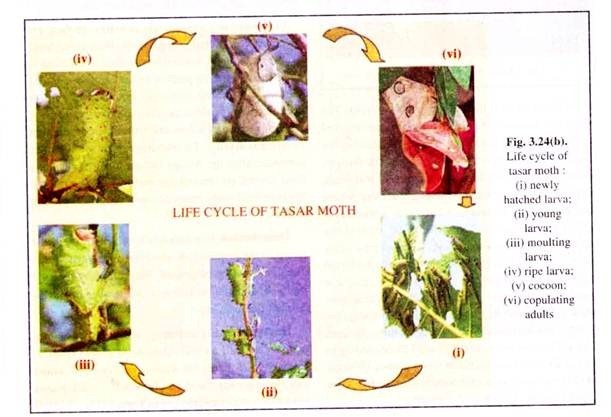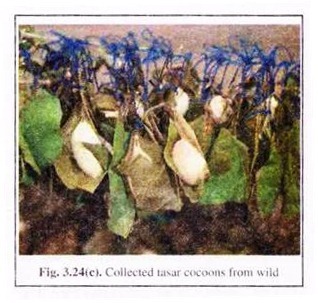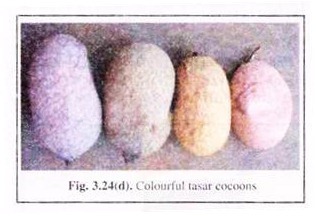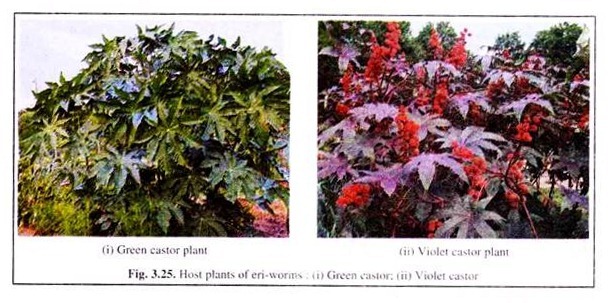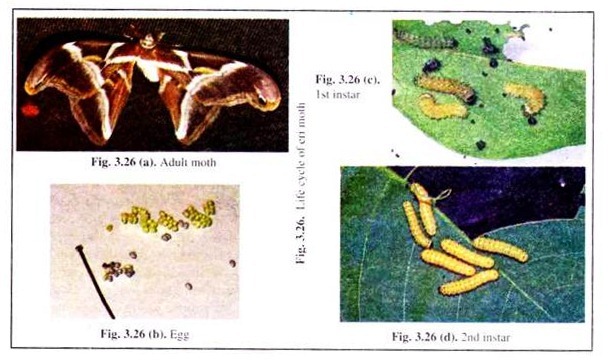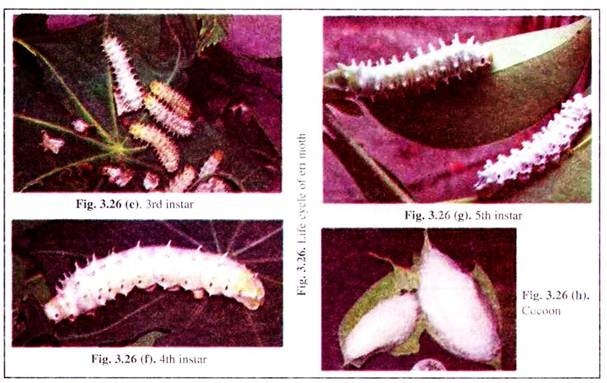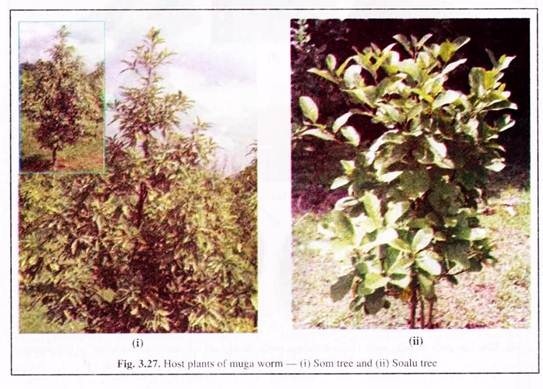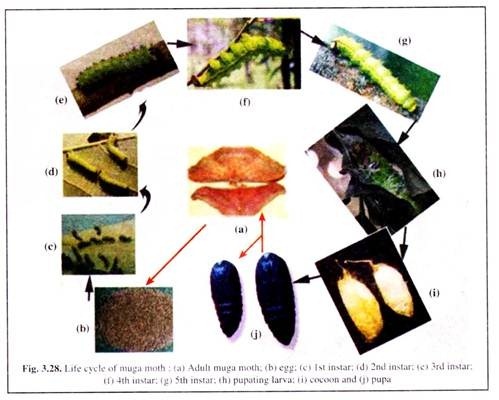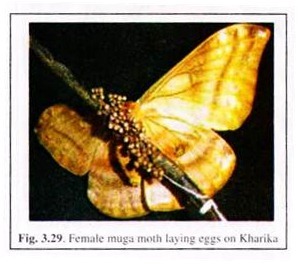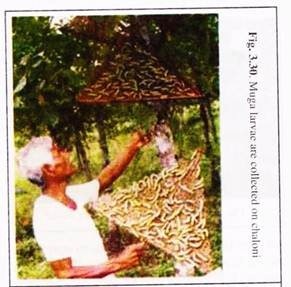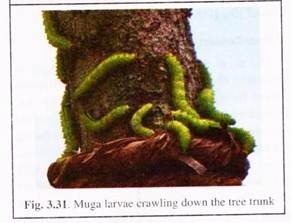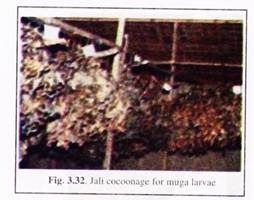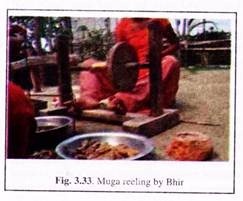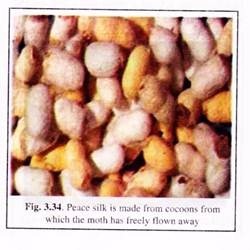In this article we will discuss about the life cycle of various silk moths:- 1. Tasar Silk Moth 2. Eri Silk Moth 3. Muga Silk Moths.
1. Tasar Silk Moth [Fig. 3.24(b)]:
Tasar silk is generated by the worm of the silk month Antheraea mylitta. It accounts for 2.0 % of total mulberry silk production in India.
Host Plants:
The larvae of Antheraea mylitta are polyphagus and can take leaves of several host plants like Arjun, Asan, Ber, Sal, Jam, Sidha, etc.
ADVERTISEMENTS:
Distribution:
This silk moth is available in China, Sri Lanka in addition to India. In India, it is available in the states of Jharkhand, Chattisgarh, Orissa, A.P. and West Bengal.
Life History:
The tasar silkworms are grown only in the wild. So they are cultivated in places where their host plants are available.
ADVERTISEMENTS:
Adult tasar moth:
By piercing one end of the cocoon the adult moths come out. Adults are very large with colourful wings spanning about 15 cm. Female has yellowish grey wings and males possess yellowish red wings with prominent eye spots on each wing (Fig. 3.24a). The males mate the females just after emergence.
Eggs:
ADVERTISEMENTS:
After copulation, the female starts laying the eggs. A single female can lay 100-150 eggs.
Larvae:
The eggs hatch within 9-10 days during summer and 15-20 days in winter. Following hatching the larvae start taking food leaves from the host plants. The worms are generally green in colour with hairs on cuticle [Fig. 3.24b (ii)].
It moults 4 times during the whole larval period that continues for 30-55 days during summer and 50-60 days during winter. The mature larvae spin cocoons which are hard with different colours according to the types of plant leaves they fed.
Some are light green, others are yellow, and some are grey and others almost white (Fig. 3.24c). Unlike mulberry cocoons, the tasar cocoon has a stalk (peduncle) which helps in fixing the cocoon with the twig of host plant [Fig. 3.24b(v)]. The tasar cocoon attains a size like that of hen’s egg.
Pupa:
The worms grow into pupae within the cocoon.
Cultivation of tasar worm:
ADVERTISEMENTS:
The tasar rearer collects the female moth from the wild and keeps it tied with the twig of host plant carefully. The males are then attracted by the pheromone secreted by the female and start copulation.
After mating the female lays eggs which are collected by the farmers and are gummed on long strips of paper- or leaf-made cup which are then hung on suitable host trees, where they hatch quite naturally. A barrier of some sort is coiled around the host tree trunks to prevent the caterpillars from wandering.
The worms after hatching start feeding the leaves. During the larval stage, which occupies up to eight weeks, guard is kept against the insect’s natural enemies such as bats, birds and beetles. On completion of the spinning, the cocoons are harvested like fruit.
Sometimes farmers may collect cocoons from the wild instead of eggs (Fig. 3.24c). Nowadays from many places, Government breeding centres also supply disease-free tasar eggs of desired breeds to the rearers.
Tasar silk:
By two methods, reeling and spinning, yarn can be produced from the cocoons. Tasar filaments show the greatest length among the non- mulberry silks, 700 m. The spun yarn is generally coarse with a denier of 270-280, while the reeled yarn is fine and thin with a denier value of 80-100.
Tasar silk has natural shades of pale gold, pinkish honey, creamy copperish, etc. depending on the colour of cocoons (Fig. 3.24d). It is less lustrous but coarser than mulberry silk. The fabric is light, airy, and stiff, and has its own feel and appeal.
Oak Tasar silk moth:
A finer variety of tasar silk is generated by the silkworm Antheraea proyeli and A. pernyi. China is the major producer of this tasars but in India it is available in Manipur, Assam, Meghalaya, Himachal Pradesh, Jammu & Kashmir.
These moths feed on leaves of oak, are found in abundance in sub-Himalayan belt. The oak tasar is finer than the common tasar silk.
2. Eri Silk Moth:
The silk worms of the silk moths Philosamia ricini and Attacus ricini generate a different kind of white silk, called eri silk.
Ericulture is a small scale industry. In fact, eri cocoon is considered as a palatable item to the local people of Assam. Castor, the host plant of eri moth is mainly used in other parts of India for production of seed as a valuable material; but in N.E. region because of its profuse vegetative growth and poor yield of seeds, the leaves are utilised for production of eri cocoon only.
To encourage the eri silk rearing commercially, the Assam Government has established several eri spun plants and research centres to provide necessary materials and suggestion to the rearers.
Distribution:
It is found in East Asia. In India, it is cultivated mainly in the North-Eastern states including Assam. Nagaland. Meghalaya, Arunachal Pradesh, and also in Bihar, Jharkhand, Karnataka, Andhra Pradesh, etc.
Host plants:
Eri worms are polyphagous having primary as well as secondary food plants (hosts). Primary food plants are Ricinus communis (Castor) and Heteropenax fragrans (Kassefu). Castor plants are of two varieties; the green leaved [Fig. 3.25(i)] and violet leaved [Fig. 3.25(ii)]. Both are equally suitable for feeding the eri silkworm.
The secondary food plants are Manihot utilissima (Tapioca). Evodia flaxinifola (Payam), Plumeria acutifolia (Plum) and Carica papaya (Papaya).
Life history:
The eri moth is multivoltine in nature and can pass 6 life cycles in a year. These worms are totally domesticated and are reared indoors.
Life cycle:
Its life cycle consists of 4 stages as follows.
Adult:
Adult moths are large with wings spanning about 10 cm. The wings are greyish brown in colour with prominent eye spot [Fig. 3.26(a)]. When the adult moth emerges from a cocoon it makes a hole to get out. Like other silk moths, eri moths also start mating activities following their emergence from pupal stage.
Egg:
Following mating, the female starts egg laying that may continue up to 3 days. Each female can lay about 350-500 eggs [Fig. 3.26(b)], Hatching depends on prevailing environmental conditions and may occur from 8-20 days.
Larvae:
The hair like newly hatched larvae are yellow in colour [Fig. 3.26(c)]. Initially they feed on soft castor leaves but at later stages, worms can feed on mature leaves. After moulting for 4 times by 30- 32 days [Figs. 3.26(a-g)] they spin the cocoon among the leaves.
Caterpillars in their final stages start spinning the cocoons. The spinning is completed in 2-3 days. The cocoons are open mouthed, tapering at one end and flat rounded at the open end. Eri cocoons are stalkless, flossy, white or brick red in colour [Fig. 3.26(h)] 5 cm long in case of female and 4.6 cm long in male.
Pupa:
Pupal stages last for 15-37 days during when larvae change to pupae.
Rearing of eri silkworm:
Disease-free seed cocoons are obtained from grainages or agencies and reared fully indoors. Healthy cocoons are spread on bamboo trays in cool dark room. On hatching, active males are separated from passive females and are then allowed to mate in quiet dark room.
Fertilised females are then tied to ‘kharikas’ by passing a thread around the thoracic joint of the right wings. Kharikas are then suspended from a string. Eggs are laid within 25 hours on Kharika and are normally selected for rearing. The eggs are white, oval and covered with a gummy substance, which makes them adhere to one another.
The eggs are disinfected with 2% formalin solution and then washed thoroughly with water. Eggs are incubated at 26°C, the colour changes to blue on the day prior to hatching. Hatching takes place in the morning after ten days of incubation. The newly hatched larvae are yellow with black segments.
These larvae are brushed to rearing trays over which few tender food leaves are spread, and crowding is avoided. As the worms advance in age, older leaves can be given as food at 2-hour interval for four to five times.
Bed cleaning is carried out at regular interval in the same way as for the mulberry silkworm. The growing worms undergo four moults and have five instar stages. Total larval period lasts for 30-35 days. The 5th instar, mature larvae stop feeding and start searching for a proper place to spin the cocoon.
At this stage, the mature worms are picked up and transferred to mountages (Chandri-kas). In wild, cocoons are spun between folds of leaves.
Post cocoon processing:
Stifling is done by spreading and exposing the cocoons to the sun for 1 -2 days. For degumming, cocoons are tied in a cloth sac and dipped in boiling soda solution. After sufficient boiling, the cocoons are taken out washed with water several times to remove soda, squeezed to remove water and then spread on mats to dry.
Being open mouthed, the thread of the cocoons is discontinuous. So, the thread can only be spun and not reeled. Traditionally, spinning is done in wet condition on takli and in semidried condition on a charkha. Improved spinning machines like N.R. Das type charkha and Chaudhury type charkha are also available for spinning of silk from eri cocoons.
Eri Silk:
The silk produced by eri moths is referred to as eri and endi or errandi silk by local people. This silk is collected from pierced cocoons, so it is spun silk. The fibres in the cocoon are like a tiny bale of cotton, all wound together and tangled. So when eri silk is spun, it forms a lower grade of silk of unusual quality.
Depending on how it is spun and woven it can give a very woolly result and as with poorly made wools, eri can feel like cheap acrylic. But it can also give a tight, strong fibre-like linen. This is what makes eri textiles amazing — they can have the drape and weight of linen but are warm and insulating like cotton or wool Eri silk is less glossy and wrinkleless.
3. Muga Silk Moths:
Muga is produced from cocoons of Antheraea assamensis which is available only in Assam. The most expensive of silks, muga, is intrinsically woven into the cultural traditions of the people of Assam. The vibrant Sualkuchi sarees and mekhla-chaddars are the traditional items made from muga silk.
The specialty of this silk is its golden bright colour. “Muga” is derived from the Assamese word ‘muga’ meaning yellowish. It is superior in every respect from the normal white silk available all over the world.
Distribution:
The native place of this moth is Assam. Its production was confined to Assam, border areas of neighboring north-eastern states and Cooch Bihar in West Bengal. Now it is reared in Nagaland, Meghalaya and Andhra Pradesh also.
Host plants:
The muga worm feeds on aromatic leaves of Som [Fig. 3.27(i)] and Soalu [Fig. 3.27(ii)]. It can also be reared on host plants similar to that of tasar worms.
Life history:
The moth is multivoltine the entire life cycle lasts for about 50 days in summer and 120 days in winter. This moth is semi-domesticated and can be raised outdoor. Muga moth (“Muga Polu’ in Assamese) also has the same life cycle as other silkworms, i.e., egg, larva, pupa and adult.
Adult muga moth:
The wings and body of the male moth are copper brown to dark brown, while those of female is yellowish to brown. Besides colouration, the male moth can be distinguished from the female by its slightly smaller size, slender abdomen, bushy antennae and sharply curved forewing tips.
Antheraea assamensis can be identified by the orange eye-spots, the pale leading edge of the forewing, and a black spot in the rear wing eye- spot located towards the body [Fig. 3.28(a)]. Typically, the males find the females upon emergence and copulate immediately.
Egg:
The female moth’s eggs (popularly known as seeds) are laid on the Som and Soalu leaves.
Larvae:
Eggs are hatched into larvae of about 2 mm long. They grow rapidly, eat voraciously and end up about 30 mm long after 4-5 weeks. During this time, they moult four times. At the end, they search suitable place for cocooning.
Pupa:
Within the cocoon the larva pupates.
Rearing of muga moth:
The seed cocoons intended for preparation of eggs are obtained from commercial rearers or from Government grainages. These are then laid in a single layer in trays to facilitate the emergence of moths. Emergence starts from dusk and continues till morning.
The emerging adults are allowed to mate and in the coupled state, the pair is tied with a piece of cotton thread to 1.5-2 feet long stick made of dried straw which is known as Kharika. After overnight mating, the couples separate in the morning and if they do not decouple naturally they are made to do so by heat of fire lighted some distance away. The female moth lays about 150-250 eggs on Kharika (Fig. 3.29).
During the rearing period, farmers restrict entry of people to the rearing plot as they believe that the evil sight of outsider may cause Mukhloga disease (Flacherie, a bacterial disease of muga). During summer, the worms hatch out in the morning in about 8 days. The Kharikas with the hatched worms are hanged on the host plants.
The larvae immediately crawl and start feeding on leaves. When the leaves are exhausted, the larvae crawl down and are collected on triangular bamboo sieves with long handles (Chaloni) Fig. 3.30, which are again hanged on a fresh tree.
A band of straw with a little sand or ash is tied around the tree trunk 1-1.2 m above the ground to prevent the worms from crawling down the ground. The larvae feed voraciously, pass through 4 moults and reach the mature stage.
In the final stage, larvae become greenish blue with prominent tubercles. Larval period lasts for 30-35 days. The ripeworms come down the trees searching for a suitable place for spinning of cocoon. They are then collected by rearers and put in baskets containing mango twigs and leaves, which are set as cocoonages (Jali) for the spinning of cocoons.
The jalies are then hung (Fig. 3.32) and left undisturbed in separate rooms or at some shady place till cocoons are formed. Dry leaves of singari, bhomloti, azar, etc. are utilised for preparation of jali by the farmers.
It is believed that cocooning in singari leaves produces shining and compact cocoons. Spinning takes about 2-3 days in summer and 7 days in winter. Muga cocoon is golden or light brown in colour, 4-6 cm long and 2-3 cm broad with a rudimentary peduncle without ring [Fig. 3.28(j)].
Post-Cocoon Processing:
The muga cocoon is compact and leathery in structure. The length of continuous silk filament ranges from 350-450 metres with 4 to 5 breaks. Immediately after removal from the mountages, cocoons are spread on bamboo mats in the sun during hot hours of the day that partially kills the chrysalis.
These are then subjected to heating in oven that kills the chrysalis completely, and thus the cocoons are stifled. For degumming of cocoon, local people use alkali (khar) made by burning banana peel/pseudo- stem or paddy straw/husk. Cocoons are boiled in such mild alkaline solutions for about 15-20 minutes.
Almost entire reeling of muga is done with a primitive machine, called Bhir or Bhawri, operated by two persons (Fig, 3.33). The cocoons are kept in basin with warm water.
Reeling requires two persons:
One person releases the filaments from cocoons while the other twists the filament into one thread and wind it on Bhir. Two persons can reel around 100 gm raw silk per day on an average. Only 40-45% silk filament is reeled and rest is rejected as waste.
Muga silk:
The silk produced is called ‘muga silk’. It is golden yellow is colour, more strong, durable and lustrous. It needs no bleaching or dying and is stain resistant. Muga farmers also produce ghisha or spun muga yarn known as jotha-muga from pierced/flimsy cocoons.
Ahimsa silk/piece silk:
This silk is woven from cocoons after the moth has flown away from the cocoon, so that the worm escapes the dip in the fatal boiling hot pail of water. Traditionally eri silk is the best example of ahimsa silk. Mr. Kusuma Rajaiah of A. P. discovered this silk.
Unlike the traditional method, where pupae are killed before reeling the yarn from the cocoon, in the production of nonviolent silk, the adult moth is allowed to emerge alive from the cocoon. Then the silk thread is spun from open ended eri or tasar cocoons and from pierced muga cocoons that have been used for breeding or those found in jungles (Fig. 3.34).
However, in Chattisgarh, crushed seeds of Mahua are used to force the worm to come out of the cocoons. The silk fibres are then extracted from those abandoned cocoons. These silk is hand-spun and hand-woven. So it takes much time and costly than the traditional silk. Non-violent or piece or ahimsa silk is made essentially from non-mulberry silk cocoons.

